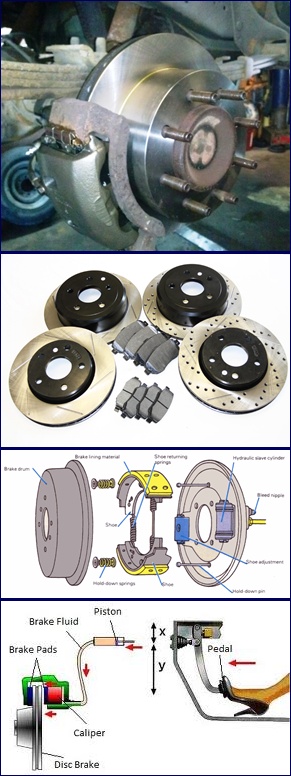Brake System Service & Repair
Your car not stopping like it used to?
Does it squeak when you press on the breaks?
We can fix that too, even if it is ABS. The replacement parts will be as good as the original or even better.
At Canada Custom Mufflers & Brakes, We perform brake replacement or repair services. Your brakes proper performance is vital to everyone‘s  safety. Canada Custom Mufflers & Brakes provides the very finest in brake service & quality.
safety. Canada Custom Mufflers & Brakes provides the very finest in brake service & quality.
At Canada Custom Mufflers & Brakes we’ will thoroughly inspect your entire brake system, explain any service we might recommend and provide you with a written estimate before we start.
Visit us soon!For All your brake replacement, repairs and services. With regular maintenance, you can keep your vehicle longer and in safe running condition.
Canada Custom Mufflers & Brakes can take care of all your Brake System requirements including:
– ABS Brake Repair
– Brake Adjustment
– Brake Lines
– Brake Bleeding
– Brake Fluid Change
– Brake Inspection
– Brake Replacement
– Brake Pads and Shoes
– Brake Rotors and Drums
Rebuild or replace Calipers
– Wheel Cylinder Replacement
– Brake Hardware Kits
– Brake Master Cylinder Replacement
Typical Wear and Tear
Brakes are a normal wear item for any car and eventually they’re going to need replacement.
– Driving habits
– Operating conditions
– Vehicle type
– The quality of brake lining material
Brake Symptoms to watch out for:
Have your brakes checked when you have any of the following symptoms…
– Your car pulls to one side during braking.
– You hear squealing or grinding noises.
– Your brake pedal pulsates up and down when you breaking.
– Your brake pedal feels soft.
– You have to press your brake pedal almost to the floor.
– Your brake warning light is on.
– Your brake pedal is low or hard to push.
– You need to frequently add brake fluid.
– You see yellow or brownish fluid leak under the car.
Braking Systems
Your car’s brake system is its most critical safety system and you should check it immediately if you suspect any problems. A properly operating brake system helps ensure safe vehicle control and operation under a wide variety of conditions.
Brake Pads and Shoes:
Brake pad and shoe friction are available in a variety of formulations such as, semi-metallic and ceramic to suit your driving needs. Brake pads and shoes are forced against a rotor or drum that creates friction to slow the vehicle and as such, are the wearable elements of your brake system that should be inspected by a certified technician annually.
Replacing worn brake pads and shoes before they get to the metal-to-metal point, can save you money. When your brake pads and shoes get to the metal-to-metal point, it usually means expensive rotor and / or drum replacement.
Brake Rotors and Drums:
Brake rotors and drums are attached to the wheel of your vehicle. They are the surfaces that the brake pads and shoes are forced against to slow or stop your vehicle. Brake rotors and drums must dissipate heat and stand up to continuous contact with water and road grit.
Brake Calipers (disc brakes):
Brake calipers are large hydraulic clamps. Calipers have one or more pistons that move outward with the increased brake fluid pressure, forcing the brake pad to contact the rotor surface thereby slowing or stopping your vehicle. When you take your foot off the brake pedal it releases the pressure, the piston retracts pulling the brake pad off of the rotor surface.
Caliper integrity is vital to the function of the brake system and can be compromised as a result of exposure to road grit, heat and contaminated brake fluid.
Brake Fluid:
Brake fluid is a specially formulated liquid used in the brake hydraulic system. Brake fluid transmits force to the various parts of the braking system when you step on the brake pedal.
Brake Hardware:
Brake hardware is used to keep brake parts in their proper location and return parts to their original location after you have applied the brakes and released them. Brake hardware related to disc brakes usually include anti-rattle springs, pad-retaining springs, shims, caliper pins, support keys, return springs and retaining screws. For drum brakes they typically include return, hold-down, adjuster springs and adjuster screw assembly.
Brake Hoses and Steel Lines:
The brake hoses and steel lines transmit the brake fluid to various elements of the braking system.
Brake Hydraulics: The brake hydraulic system consists of the master cylinder, hydraulic lines and hoses. When you apply pressure to the brake pedal the resulting force generates pressure in the master cylinder, which then flows through the lines and hoses to the wheel cylinders and/or calipers forcing the brake shoes or pads against the drums or rotors. It is important to check the brake fluid in the master cylinder reservoir regularly. If you need to add brake fluid frequently you should have the system checked as soon as possible by a qualified technician.
ABS Brakes:
ABS (Anti-Lock Braking System) consists of a set of sensors for each wheel that notifies a computer when the wheel locks during extreme or emergency braking conditions. The computer releases the brake many times per second eliminating the need to pump the brake pedal allowing the driver to maintain steering control.
Although your ABS warning light is on, your main braking system is unaffected and you will be able to stop. You should have your brakes serviced as soon as possible.
